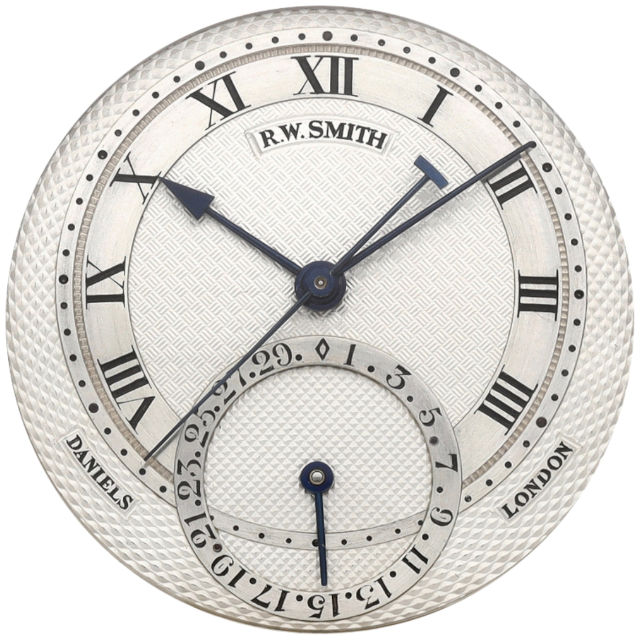I was recently asked to research and write the catalogue for two exceptional watches being offered by Sotheby’s Geneva on 5 November 2023: Roger Smith’s personal white gold Millennium watch and the first George Daniels Anniversary wristwatch.
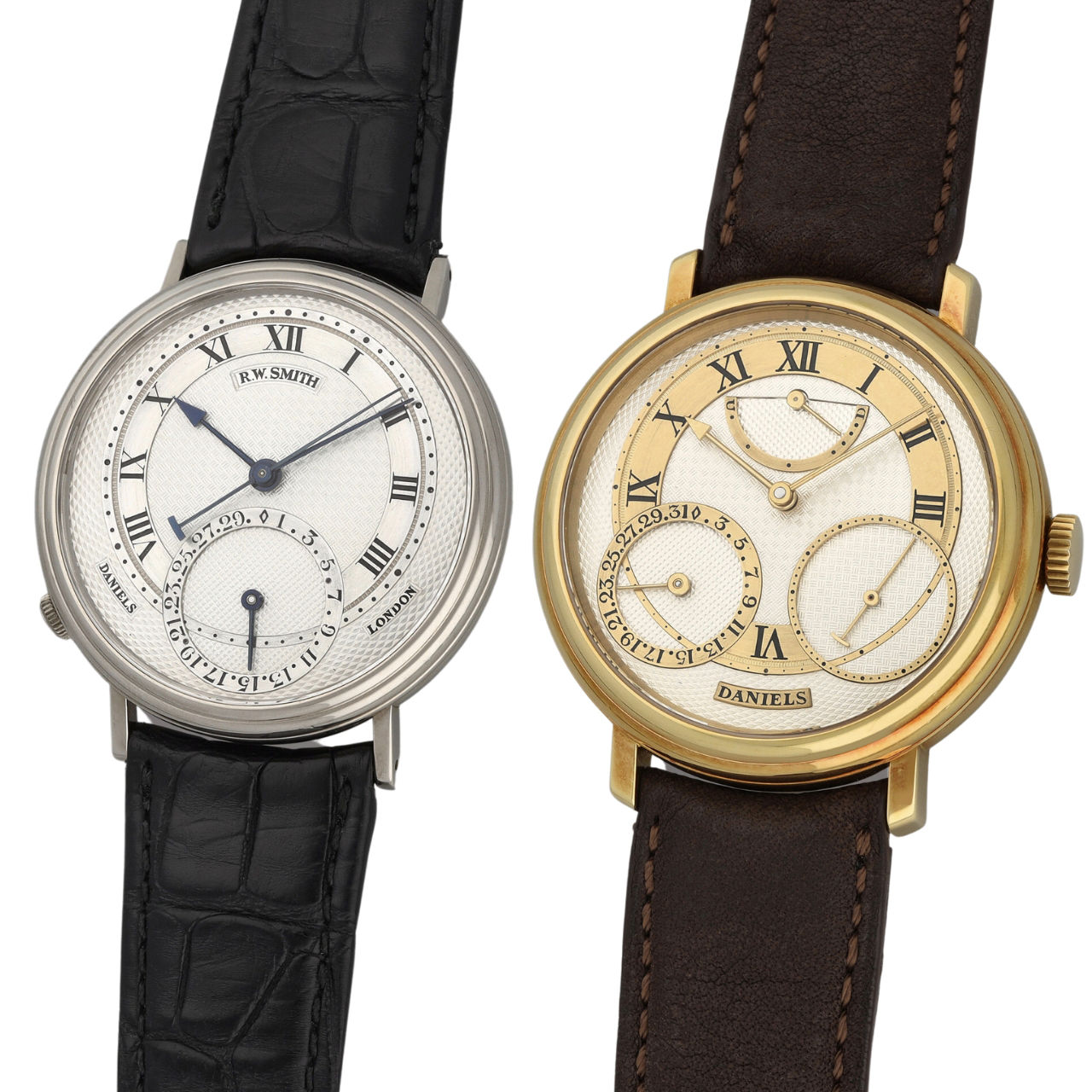
Roger Smith’s white gold Millennium wristwatch (left); George Daniels Anniversary No.1 (right) images © Sotheby’s
An exceptional and fascinating pair of watches, the Millennium and Anniversary watches shown here are of great significance to modern horology. No other wristwatches could more clearly mark the transference of skill and knowledge from Master to Apprentice than the two watches illustrated and discussed here.
Between them, these watches mark the culmination of Dr. George Daniels’s career and the rise to independence of his successor, Dr. Roger Smith. Indeed, the unique co-signed Daniels/Smith white gold Millennium and the Anniversary No.1 represent the bridge between the greatest British watchmaker of the 20th century and the greatest living British watchmaker of the 21st century.
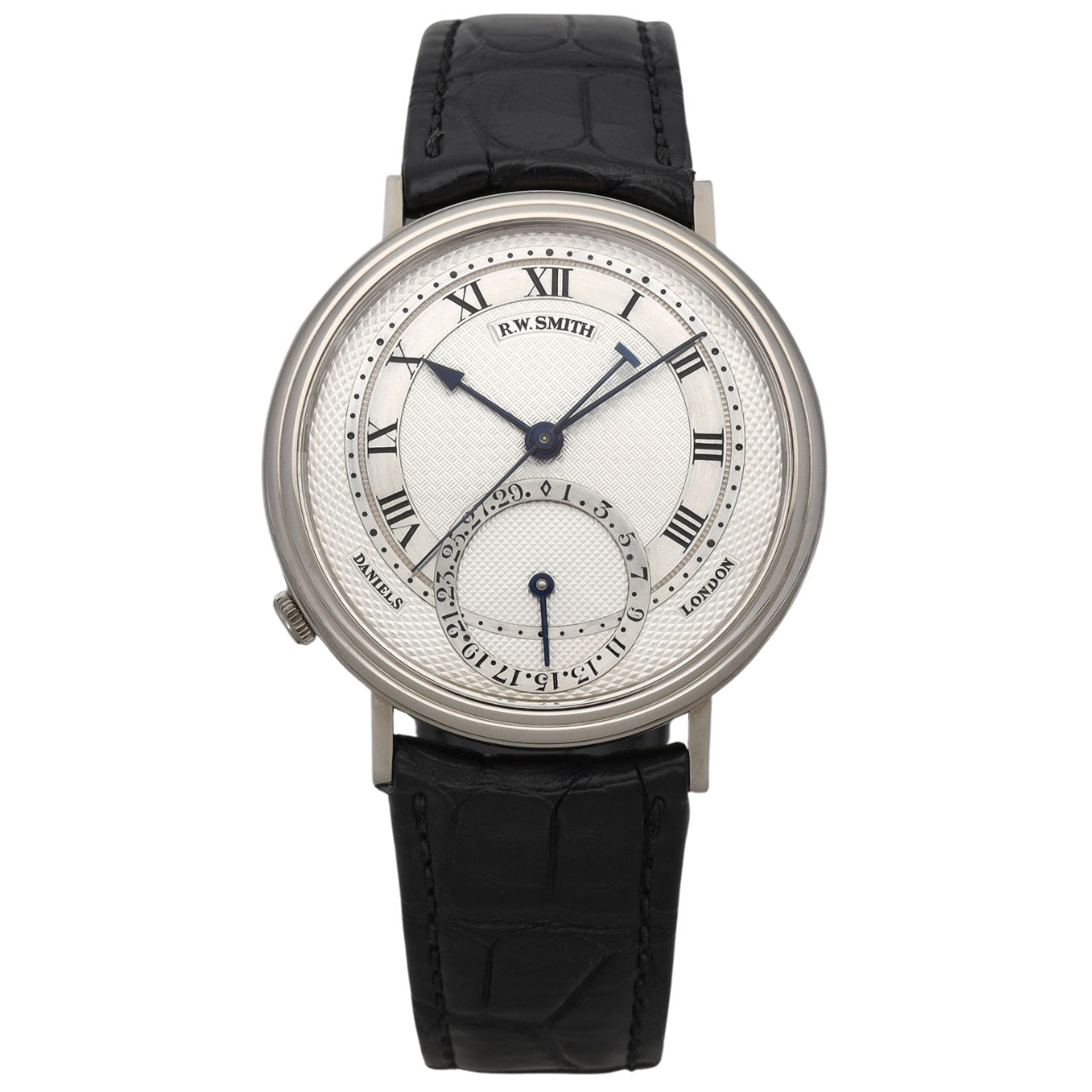
Roger Smith’s White Gold Millennium – the last George Daniels Millennium watch to be made – image © Sotheby’s
Completed in 2001, this is the last example from the Millennium series of watches to be made and was specially assigned to Roger Smith by George Daniels. Excited by the prospect of owning a watch by his master and mentor, and in recognition of his own work on the Millennium watches, Smith asked for permission to co-sign the dial – a request readily agreed to by Daniels. This is the only watch ever signed by both Daniels and Smith. The watch is additionally engraved to the back of the case Roger W. Smith together with the year of production ‘01’. Some months after the watch’s completion, Smith took the difficult decision to privately sell the watch to a collector to help fund and realise Smith’s dream of creating his own watchmaking business – Roger W. Smith Ltd – a firm that is now one of the leading independent watchmakers in the world.
Offered at Sotheby’s Geneva on 5th November 2023 by the same private collector, the ‘Daniels/Smith’ white gold millennium was sold for a record CHF 2,177,500 (£1.95million / US$ 2.4 million).
Dr. Roger Smith O.B.E. (b.1970) first met Dr. George Daniels M.B.E. (1926-2011) in 1988 while studying at Manchester’s School of Horology. Just 18 years of age, Smith was captivated by Daniels’s mastery of horology, astonished to learn that Daniels made every component of his watches himself, and fascinated by Daniels’s drive and belief in his own ability to improve the mechanical timekeeper. One should remember that, in 1988, the mechanical watch industry was only just beginning to recover from the decimation wreaked by the quartz crisis of the 1970s and early 80s. At the time, many saw little real future for the mechanical watch, so for the young Smith to see the confidence, passion and talent demonstrated by Daniels greatly inspired the young student’s imagination; in fact, that day in Manchester would change the course of Smith’s life.
Smith next met Daniels in 1990. At the time Smith was working as a watch repairer, changing batteries and fixing bracelets, but he found his mind continually wandered back to the day he met Daniels in Manchester. Smith resolved to write to Daniels and ask if he could work as his apprentice. A reply arrived, stating that while Daniels did not want to employ an apprentice, he would be pleased if Smith would visit his workshop on the Isle of Man. When the day arrived and the two met once more, Smith impressed upon Daniels his desire to make his own watch and, encouraged by the master to do so, over the following months and years he set about making his first watch, a one-minute tourbillon pocket watch with spring- detent escapement. Smith took the watch to show Daniels in 1992 and was rather crestfallen with the reception that both he and the watch received.
Over the next five and a half years, Smith spent his time mastering the 34 different trades essential to the craftsman of a truly handmade watch, remaking his next watch four times in the process. Finally ready, he apprehensively travelled once more to meet with Daniels in 1997. Following a somewhat brusque welcome, Daniels set about examining Smith’s new watch. After a tense silence, Daniels’s questions began: ‘Who made your case?…and the dial?…Who made your escape wheel?…Who made your spring detent?…Who made your tourbillon cage?’ To all these questions Smith could answer simply: ‘I did’. The questions over, a smile crept over Daniels’s face as he announced: ‘Congratulations, you are now a watchmaker!’
After this encounter Smith initially returned to his trade repair work until a life changing call came from Daniels, asking him to come and work for him on a new project. At the time Daniels’s co-axial escapement had just been taken on by Omega and Daniels wanted to create a small series of watches based on the new Omega ébauche.
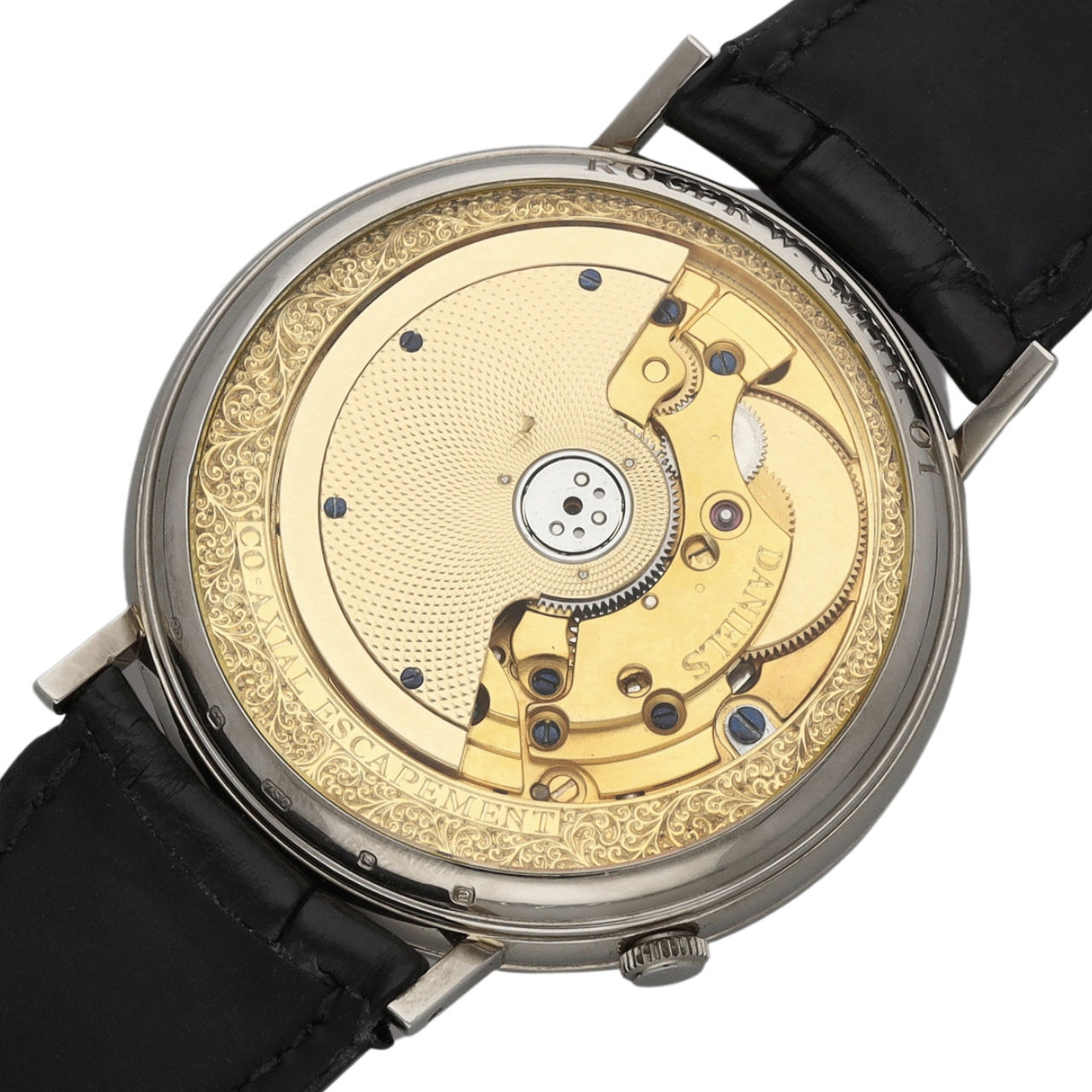
The display back of the white gold Smith/Daniels Millennium reveals the movement. The rim of the case back is engraved Roger W. Smith with the year of production (20)01. Image © Sotheby’s
After several years of negotiation and development, Omega launched their version of Daniels’s co-axial escapement at the Basel watch fair in 1999 and as part of the agreement reached between its inventor and Omega, Daniels was to be supplied with a small number of Omega’s co-axial ébauches. It was these movements that would form the basis of the Millennium wristwatch project with each movement re-worked by Daniels and Smith in the English style with gilded plates and blued steel screws, as well as a special calendar module. Smith began work on the project at Daniels’s workshop on 2 January 1998. Before long a substantial wait list had been created for the Millennium wristwatches and between 1998 and 2001, 56 Millennium wristwatches were made of which 49 (including the prototype) were made in yellow gold and just 7 in white gold. All aspects of the Millennium watches were meticulously designed and considered, including the exceptional engine- turned dials that Daniels taught Smith how to make and master, and their hands which were cut and filed by hand.
With all the Millennium watches complete, Smith left Daniels’s employ and set up his own watchmaking business and so Roger W. Smith Ltd was born. Smith’s ambition was to create his own lineage of completely handmade, series-produced wristwatches. Daniels helped ease Smith’s transition to independence by commissioning two rectangular tourbillon wristwatches to be made under the Daniels name. While working on his own watches, Smith would continue to collaborate with Daniels over the following years. In 2009, Daniels approached Smith with a new project, the Daniels Anniversary Watch.
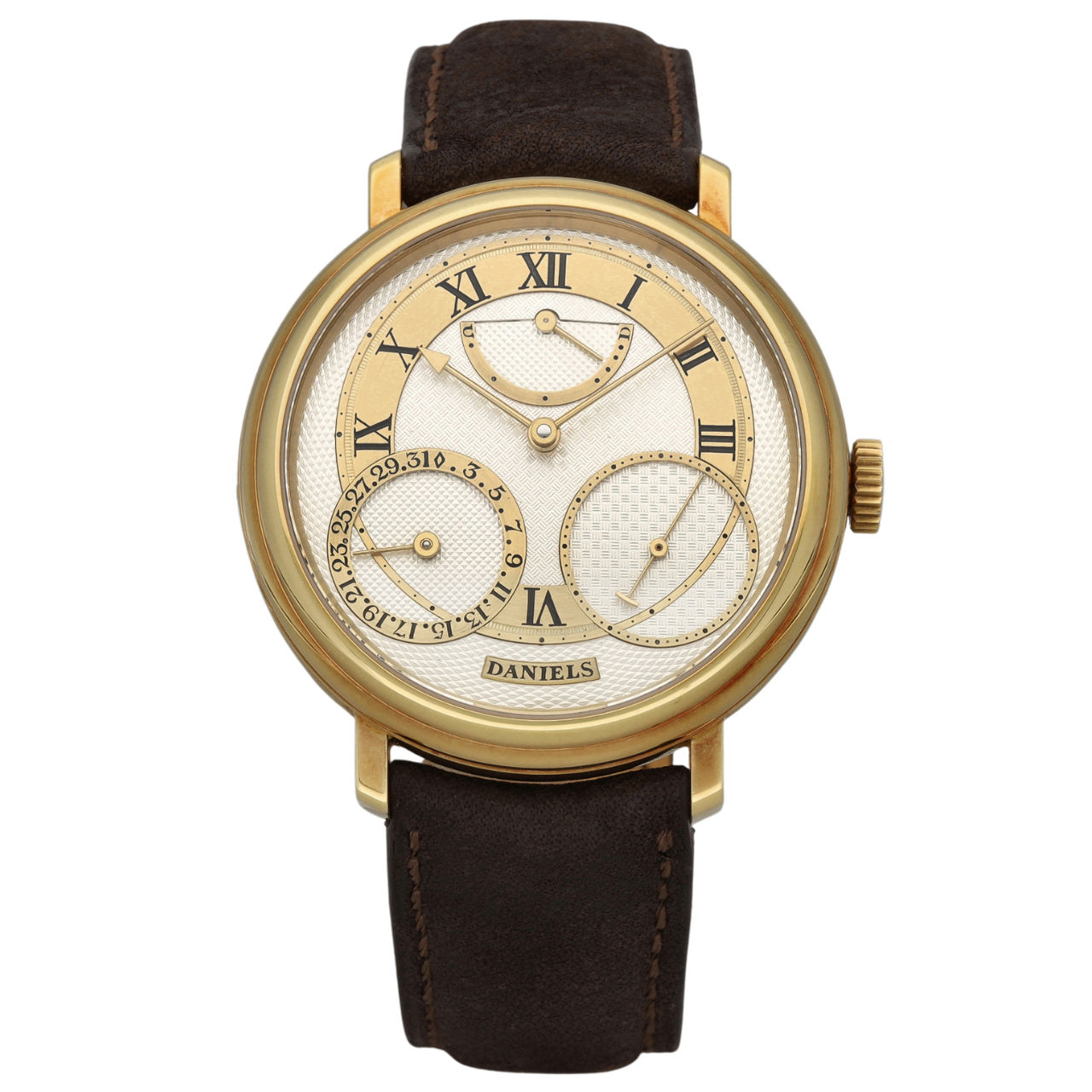
George Daniels Anniversary wristwatch No. 1. Image © Sotheby’s
To mark 35 years since the invention of the co-axial, Daniels was determined to create a new series of wristwatches incorporating his patented escapement. However, unlike the Millennium wristwatches that used the Omega base calibre, the Anniversary would have an entirely new English wristwatch calibre designed and wholly made in Daniels’s Isle of Man workshop. The ‘Daniels Anniversary’ was to be a celebration of the handmade wristwatch and limited to just 35 pieces, marking the 35 years since the co-axial’s invention. Offered here is the first wristwatch from the series which is prominently numbered 1 to the backplate. It was also the first wristwatch to have been designed and made in its entirety on the Isle of Man, and the Manx triskelion can be seen engraved to a special plaque beside the watch’s escapement.
Made for the same collector who purchased the Daniels/Smith co-signed white gold millennium watch, the Anniversary No. 1 is offered at Sotheby’s Geneva on 5th November 2023 for the very first time.
A significant feature of the Anniversary wristwatches was their use of Smith’s single wheel version of the Daniels co-axial escapement, the incorporation of which was agreed by Daniels himself – a clear illustration of the Master’s admiration for Smith’s own talents and the collaborative nature of the Anniversary project. Made by hand, the eccentric silver dials were enhanced with multiple decorative engine-turned finishes and inlaid with gold chapters; the hands were also handmade. Cased in 18ct gold, the watches were fitted with sapphire crystal case backs, allowing the co-axial escapement to be viewed and appreciated in action. At the time the Anniversary project was initiated, George Daniels was 83 years of age. On 21 October 2011, just two weeks before the prototype and the movement of No. 1 were due to be shown in London at SalonQP, Daniels passed away; with his death, completion of the Anniversary watches fell to Smith alone.
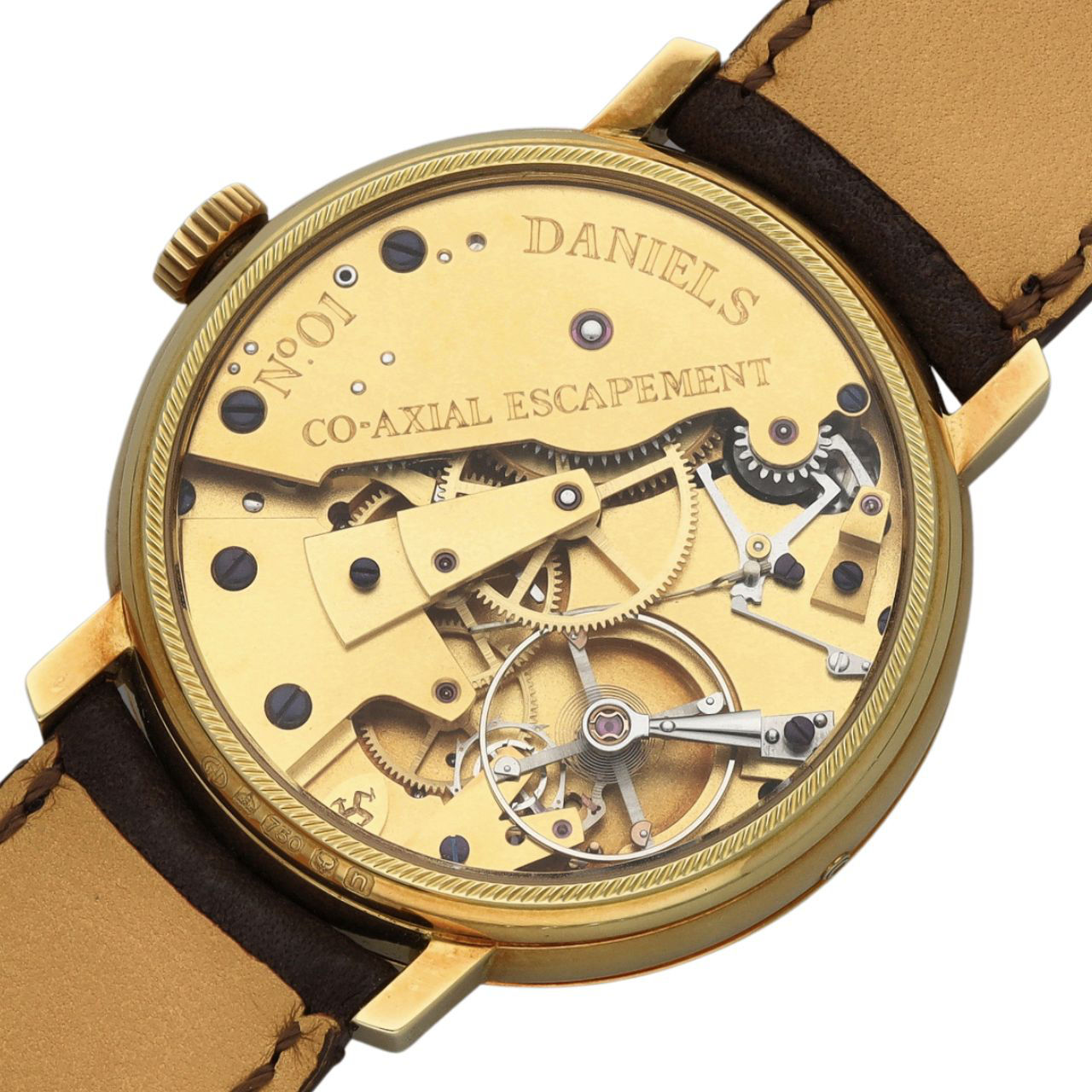
The glazed case back of the George Daniels Anniversary No.1 reveals the movement. Roger Smith’s single wheel version of the Daniels co-axial escapement can be seen in the photo beneath the lower left side of the balance. Image © Sotheby’s
It is easy to forget just how remarkable the invention of the co-axial escapement was. Invented in 1976 and patented in 1980, the co-axial was the first serious challenge to the dominance of the ubiquitous lever escapement, the latter invented more than two hundred years before by another Englishman, Thomas Mudge in circa 1754. Although of English origin, the lever escapement was further developed and perfected by the Swiss and was the dominant form of watch escapement for much of the 19th and throughout the 20th century. A detached escapement, the fork of the lever escapement impulses the balance in both directions of the balance’s swing and is detached between each impulse, thereby reducing friction. However, the lever’s pallet jewels create a sliding friction as they engage with the escape wheel. To reduce this friction, lubrication is required; yet, as the lubricant degrades, so the impulse is weakened, the balance amplitude drops, wear is increased, and servicing becomes necessary. In the co-axial escapement, impulse is given directly to the balance by the escape wheel using a pushing rather than sliding motion. Creating tangential rather than sliding friction, it does not require lubrication. It is this manner of impulse which applies some of the principles of the chronometer escapement but with the co-axial’s advantage of impulsing the balance in both directions of its swing (the chronometer escapement impulses the balance in one direction only and is not self-starting).
The action of the co-axial escapement and reduction in the need for lubrication greatly improves the movement’s performance and allows much longer intervals between servicing, thereby giving the watch a more consistent and reliable performance. The co-axial escapement’s origins lie in a commission given to George Daniels in the early 1970s by the great collector and owner of the Time Museum, Seth Atwood, who requested a watch that incorporated a new invention
to improve the mechanical watch’s performance. This led to the creation of the first watch with Daniels’s own escapement – the Daniels independent double-wheel escapement. This escapement utilized two mainspring barrels, two symmetrical trains, two escape wheels and a ‘Y’-shaped central locking detent with three pallets. A masterpiece of design, the movement was almost perfectly symmetrical but with an almost doubling in the number of parts required to make the movement, its application was more suited to being housed within a pocket rather than wristwatch case.
Daniels knew that to convince the watchmaking world of the suitability of his new escapement for general production, an alternative had to be found, and so the smaller and slimmer co-axial escapement was born. The first watch with co-axial escapement was completed in 1979 and sold to the collector Esmond Bradley Martin in 1983.3 In 1986, Daniels exhibited at the Basel Watch Fair, showing a display of wristwatches all with his co-axial escapement – these included two entirely of his own creation and five further examples by Omega, Rolex, Patek Philippe, Zenith and Jürgensen, all of which had been modified by Daniels to include his own co-axial escapement. During the 1990s Daniels entered into discussions with the Swiss movement manufacturer ETA, which would eventually lead to the co-axial’s adoption by Omega; Omega released their first wristwatches with Daniels’s co-axial escapement in 1999. It is truly remarkable that Dr. Daniels managed to persuade a Swiss manufacturer to take on his escapement as an alternative to the lever escapement which the Swiss had so successfully and energetically developed throughout the modern era. Indeed, there can be no greater testament to the genius and success of the co-axial than its adoption by Omega for series production, particularly when one considers the extremely rigorous testing the escapement had to endure before its acceptance by the brand.
These two watches were sold at Sotheby’s Geneva on 5th November 2023 as lots 97 and 98 for the following prices:
Roger Smith’s white gold Millennium – CHF 2,177,500 (£1.95million / US$ 2.4 million).
George Daniels Anniversary No.1 – CHF 736,600 (£662,300 / US$820,800).
